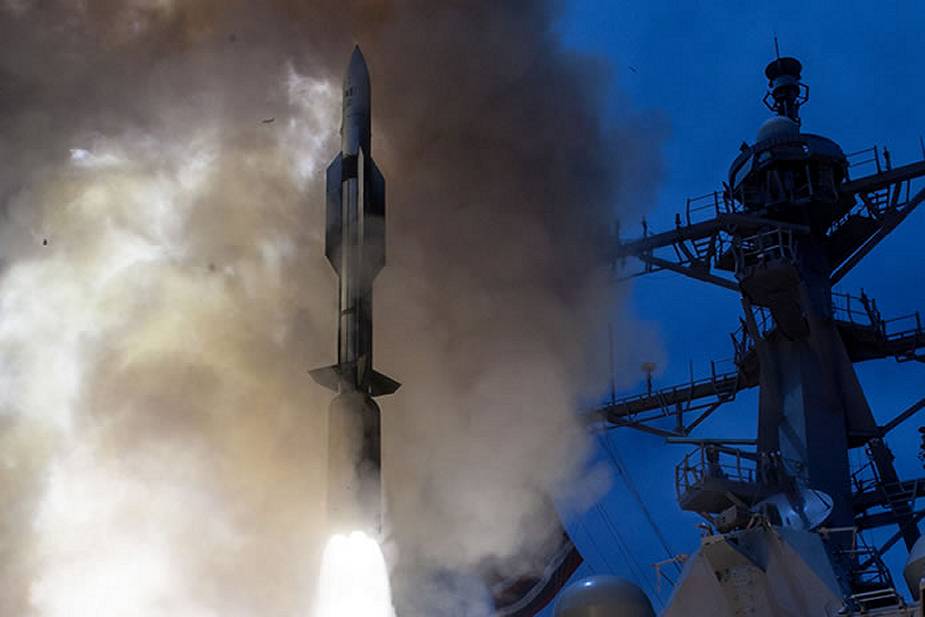According to information published by the Missile Defence Advocacy Alliance website, the United States has developed a new version of the SM-6, a missile in current production for the United States Navy. The SM-6 Block IB will be able to shot down hypersonic missiles.
The SM-6 was designed by the American company Raytheon to provide capability against fixed and rotary-wing aircraft, unmanned aerial vehicles, anti-ship cruise missiles in flight, both over sea and land, and terminal ballistic missile defense. It can also be used as a high-speed anti-ship missile.
The SM-6 is a multi-mission missile that can perform anti-air warfare, ballistic missile defense, and anti-surface warfare missions. It is a two-stage missile with a booster stage and a second stage. The missile has a 64 kg blast fragmentation warhead and has an operational range of 240 km.
According to a report the United States Congress, the United States Missile Defense Agency (MDA) and Space Development Agency (SDA) are currently developing elements of a hypersonic missile defense system to defend against hypersonic weapons and other emerging missile threats.
According to a report of the U.S. Senate, the United States Department of Defense works with the U.S. Missile Defense Agency to accelerate a comprehensive layered defeat capability against adversary tactical hypersonic weapons including kinetic defense in the terminal and glide phases of flight, as well as left-of-launch strike of missile launch complexes. The U.S. DoD is investing in technologies and studying capabilities to defeat regional offensive hypersonic weapons, the first element of which is to detect and track incoming missile threats.
Citing The Drive website, The U.S. MDA (Missile Defense Agency), in cooperation with the U.S. Navy, demonstrated early capability against maneuvering threats during flight-testing of the Standard Missile (SM)-6 Sea-Based Terminal (SBT) defense, and it will further demonstrate this capability against an advanced maneuvering threat-representative target later this year, said Senator Barbara McQuiston.
Hypersonic weapons, like ballistic missiles, fly at speeds of at least Mach 5, or roughly 1 mile per second. Unlike ballistic missiles, hypersonic weapons do not follow a ballistic trajectory and can maneuver en route to their target. Russia reportedly fielded its first hypersonic weapons in December 2019, while China is expected to field its first in 2020. The United States is not expected to field hypersonic weapons before 2023.
Hypersonic systems take advantage of speed, maneuverability and sustained flight in the altitude gap between air defenses and ballistic missile defenses to provide transformational capability for survivable, long-range, lethal, time-critical strike of heavily defended and high value targets.
Currently, there is no operational radar in the world able to detect hypersonic weapons but Russia has announced in April 2021, that the Rezonans-N radar is capable of spotting hypersonic missiles and will be deployed in June 2021.

 www.navyrecognition.com
www.navyrecognition.com
The SM-6 was designed by the American company Raytheon to provide capability against fixed and rotary-wing aircraft, unmanned aerial vehicles, anti-ship cruise missiles in flight, both over sea and land, and terminal ballistic missile defense. It can also be used as a high-speed anti-ship missile.
The SM-6 is a multi-mission missile that can perform anti-air warfare, ballistic missile defense, and anti-surface warfare missions. It is a two-stage missile with a booster stage and a second stage. The missile has a 64 kg blast fragmentation warhead and has an operational range of 240 km.
According to a report the United States Congress, the United States Missile Defense Agency (MDA) and Space Development Agency (SDA) are currently developing elements of a hypersonic missile defense system to defend against hypersonic weapons and other emerging missile threats.
According to a report of the U.S. Senate, the United States Department of Defense works with the U.S. Missile Defense Agency to accelerate a comprehensive layered defeat capability against adversary tactical hypersonic weapons including kinetic defense in the terminal and glide phases of flight, as well as left-of-launch strike of missile launch complexes. The U.S. DoD is investing in technologies and studying capabilities to defeat regional offensive hypersonic weapons, the first element of which is to detect and track incoming missile threats.
Citing The Drive website, The U.S. MDA (Missile Defense Agency), in cooperation with the U.S. Navy, demonstrated early capability against maneuvering threats during flight-testing of the Standard Missile (SM)-6 Sea-Based Terminal (SBT) defense, and it will further demonstrate this capability against an advanced maneuvering threat-representative target later this year, said Senator Barbara McQuiston.
Hypersonic weapons, like ballistic missiles, fly at speeds of at least Mach 5, or roughly 1 mile per second. Unlike ballistic missiles, hypersonic weapons do not follow a ballistic trajectory and can maneuver en route to their target. Russia reportedly fielded its first hypersonic weapons in December 2019, while China is expected to field its first in 2020. The United States is not expected to field hypersonic weapons before 2023.
Hypersonic systems take advantage of speed, maneuverability and sustained flight in the altitude gap between air defenses and ballistic missile defenses to provide transformational capability for survivable, long-range, lethal, time-critical strike of heavily defended and high value targets.
Currently, there is no operational radar in the world able to detect hypersonic weapons but Russia has announced in April 2021, that the Rezonans-N radar is capable of spotting hypersonic missiles and will be deployed in June 2021.

United States has developed new SM-6 Block IB missile able to shot down hypersonic threats
United States has developed a new version of the SM-6, a missile in current production for the United States Navy. The Block IB will be able to shot down hypersonic missiles

